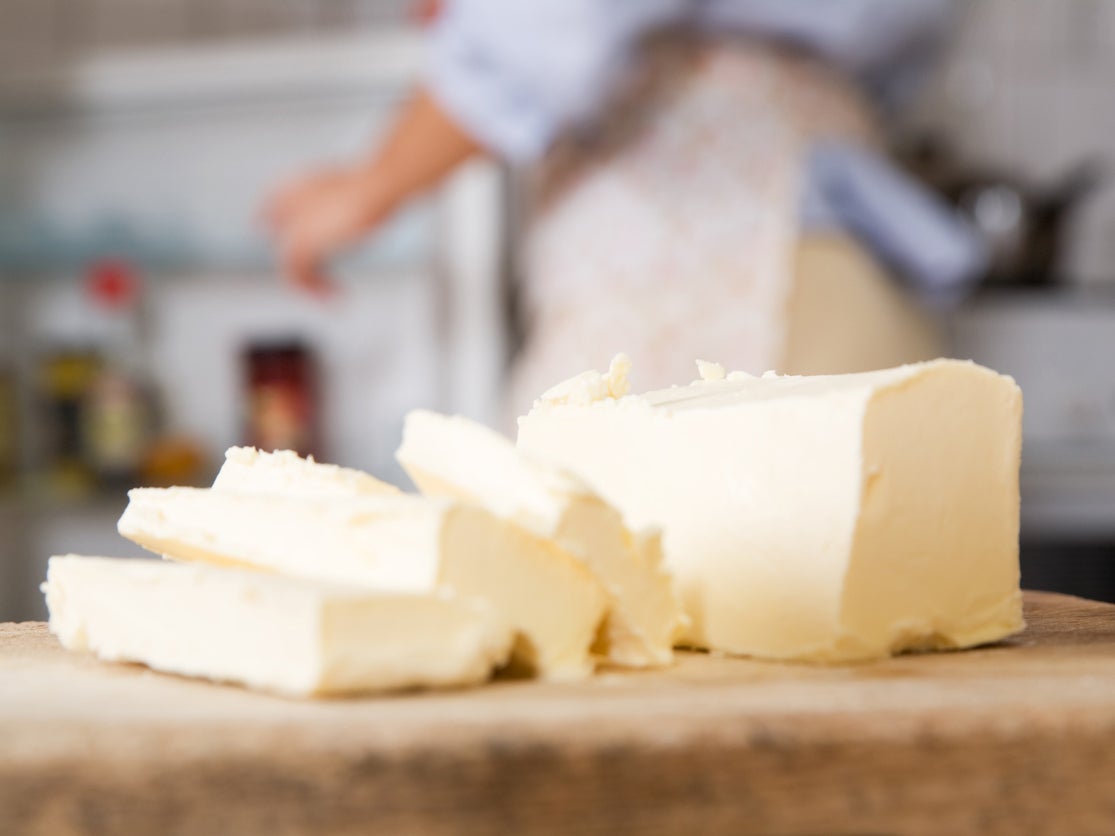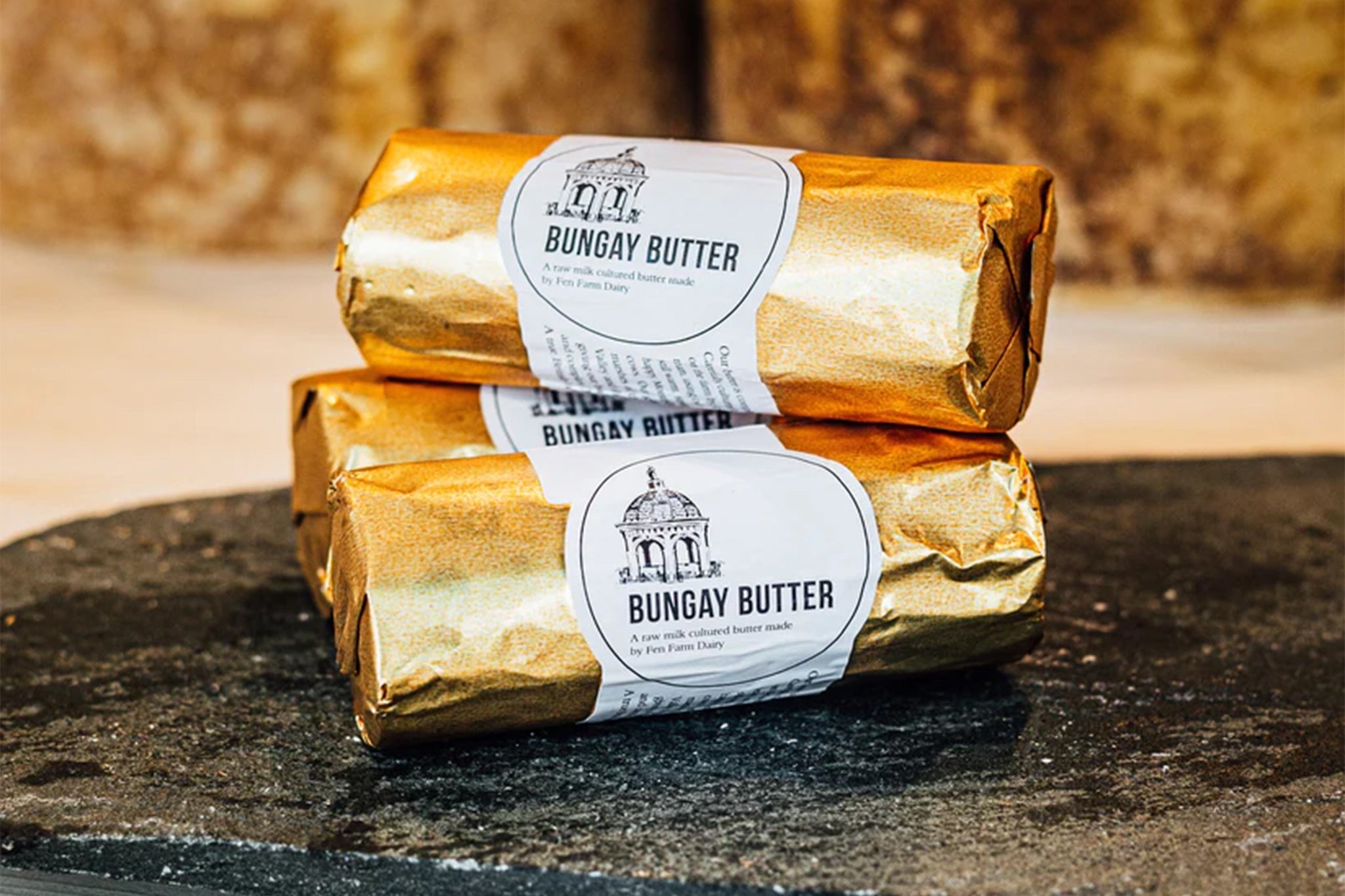The Independent's journalism is supported by our readers. When you purchase through links on our site, we may earn commission.
Gold rush: why luxury butter is whipping up a frenzy with foodies
Margarine be damned – butter is back and bigger than ever. Sarah Barratt is here to spread the word

Remember when Instagram was dominated by avo toast and matcha lattes? Well, move over green food: the future is golden. Yes, butter is the latest ingredient that’s whipping social media into a frenzy. People are churning their own, blending it with bone marrow and black garlic – and even eating it with a spoon from the packet. As a result, the butter hashtag boasts 24 billion views on TikTok alone. Avocado, meanwhile, sits at a measly 200 million.
“Fantastic butter can elevate everyday cooking,” says Thomas Straker, whose viral content kickstarted the trend. The London-based chef began uploading videos of himself whisking you-know-what with a variety of ingredients (marmite, miso, chicken skin) in 2020. Word quickly spread. Today, he is the poster boy for butter – boasting over 4 million followers on Instagram and TikTok combined. He has even launched his own brand: All Things Butter.
A great pack of butter, Straker says, begins with quality cream. His is sourced from an organic farm in Somerset and churned twice using machines previously used to make France’s famous Beurre d’Isigny. “The butter comes out unstructured with lovely cracks where salt can fall in. This makes the flavour stand out,” he says. Alongside salted and unsalted, All Things Butter is available flavoured with garlic and herbs, or chilli. “If you add liquid to our flavoured butter you can make a lovely emulsified sauce,” says Straker. “One of my favourite ways to use it is heating some in a pan then adding chicken stock. It’s great on pasta. Add parmesan and black pepper and you have a delicious dish.”

Luxury butter, it turns out, is a cash cow: packs of Straker’s – which regularly sell out – cost around £3 on Ocado. The online supermarket’s own-brand range, by comparison, is priced at £1.69. Still, in the grand scheme of churned cream, £3 is a steal. The Newt’s flavoured versions, which include “Sublime Chimichurri” and “Sublime Truffle, Parmesan and Black Pepper” will knock you back £4.50. Meanwhile, a pack of Quicke’s Cow’s Whey Butter – a by-product of the cheese-making process – costs just over £5 (available in all good Gail’s bakeries).
Then there’s Bungay Butter. Made at Fen Farm Dairy in Suffolk, it comes hand-wrapped in gold paper and packed in a wooden box. Yours for £7.50. In its defence, it is the UK’s only raw cultured farmhouse version – made using milk from grass-fed Montbéliarde cows. “They’re an ancient breed that only give a small amount of milk – but it is rich and high in protein, producing creamy and complex flavours,” says farmer Dulcie Crickmore. “We use the milk warm from milking – souring cream using lactic bacteria, before churning and hand-padding it using traditional wooden ‘butter hands’. It’s the closest thing to the original Suffolk butter.”
Food writer and chef Olivia Potts (@oliviafpotts) is a fan. “Cultured butter is the butter equivalent of sourdough, where naturally occurring bacteria are introduced and allowed to ferment. It’s impossible to do at an industrial scale and each batch is unique. It’s my favourite kind of butter: you get a literal taste of the dairy’s skill and surroundings,” she says.
Basting a fillet of fish or head of cauliflower with a generous knob of deliciously flavoured butter transforms a simple dish into a very special meal
The author of Butter: A Celebration, Potts waxes lyrical about what she calls “the ultimate ingredient”.
“Butter is simple in one sense, and a cornerstone of cooking. But in another it’s complicated: it’s an emulsion, with naturally occurring sugars, and it melts at body temperature which makes it a powerful flavour carrier,” she muses. “These characteristics mean that even a small amount can transform texture and flavour in a staggering way.”
According to Potts, different varieties meet different needs. She likes to cook with Breton butter, which is traditionally very salty. But when it comes to toast, she opts for the hand-rolled organic salted variety from Hollis Mead dairy. Meanwhile, the Edinburgh Butter Co’s cultured “butter sheets” are ideal for laminating pastry. Potts also likes to make her own “compounds” – whipping softened butter with flavourful ingredients, returning it to the fridge wrapped in wax paper. Whatever the dish, there’s a compound to accompany it: “Marmite butter and crisped chicken skin butter to spread directly onto bread, herbed butter for steamed veg – and orange, honey and cardamom butter to sit on hot porridge,” she says.

Chef Sophie Rushton-Smith (@TheCornerPlot) goes one step further – making her own butter from scratch. “I enjoy the process of making it as much as I do eating it,” she says. “The alchemy of transforming double cream into a slab of butter is enormously satisfying to watch.” The internet agrees: a video of Rushton-Smith doing exactly that has been viewed by 70 million people. “I think it reminds people of their childhood, of grandparents, of different times. For some, it triggers an old memory of shaking a jam jar of double cream until your shoulders ache at primary school. In others, it causes misbelief – people simply cannot believe how much golden butter is contained in cream,” she muses. Plus, she adds, butter possesses serious powers: “Basting a fillet of fish or head of cauliflower with a generous knob of deliciously flavoured butter transforms a simple dish into a very special meal.”
The key to great butter, Rushton-Smith says, is great cream – echoing Straker’s sentiment. “I use Tom Parker Creamery’s double cream, from free-range cows. It works every time, taking just a few minutes to churn. I tried a supermarket brand recently, and it failed to churn into butter twice, making me wonder what they’ve added or what they’ve taken away,” she says.
Still – even if it does hail from happy cows – homemade butter isn’t exactly healthy. “Unlike fermented dairy products like cheese and kefir, butter has no health benefits,” says Dr Tim Spector, co-founder of ZOE and author of The Sunday Times best-selling Food for Life. “But it’s likely better for us than artificial spreads, which can be heavily processed and packed with artificial ingredients. We don’t know precisely how these ingredients impact our long-term health, but the research doesn’t look good.”
So, Spector would opt for butter over marge? “If you’d asked this question a couple of decades ago, I would have said ‘no’,” he says. “Today, I always choose butter over margarine – but I limit my intake.” What about butter of the spreadable variety? “It depends on what’s been added to it, so it’s best to check the label. If there are various artificial ingredients added, then I’d personally opt for the standard butter instead.”
As far as Spector is concerned, pasture-fed varieties are the cream of the crop. “Butter from grass-fed cows is higher in vitamin A and omega-3s. And if they’re accessible, organic products are generally likely to be healthier. Having said that, butter should be enjoyed in moderation, both for our health and for the environment.” Hmm. In that case, probably best to avoid eating it with a spoon straight from the packet. Then again, as Oscar Wilde said, “everything in moderation, including moderation”. Surely he was talking about butter.






Join our commenting forum
Join thought-provoking conversations, follow other Independent readers and see their replies
Comments